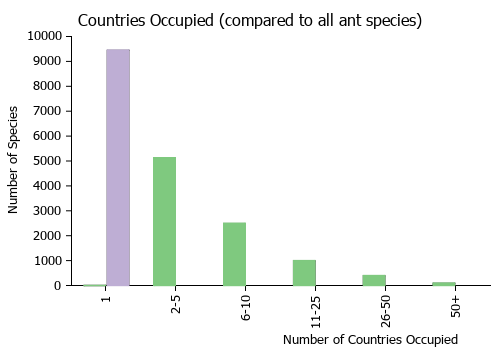Aenictus henanensis
| Aenictus henanensis | |
|---|---|

| |
| Scientific classification | |
| Kingdom: | Animalia |
| Phylum: | Arthropoda |
| Class: | Insecta |
| Order: | Hymenoptera |
| Family: | Formicidae |
| Subfamily: | Dorylinae |
| Genus: | Aenictus |
| Species: | A. henanensis |
| Binomial name | |
| Aenictus henanensis Li & Wang, Y.-L., 2005 | |
The type material was collected from the ground in a forest.
Identification
A member of the ceylonicus group.
Li and Wang (2005) - Close to Aenictus lifuiae, but in profile view dorsum of propodeum straight, dorsum of petiolar node roundly convex, dorsum of propodeum entirely microreticulate. The new species is also close to Aenictus ceylonicus, but mandible with a large apical tooth, a small preapical tooth and followed by 5 indistinct minute denticles, subpetiolar process low and rounded, anterior half of pronotum microreticulate.
Key to Aenictus species groups
Keys including this Species
- Key to southeastern Asian Aenictus ceylonicus group species
- Key to Aenictus ceylonicus group species of China
Distribution
Distribution based on Regional Taxon Lists
Palaearctic Region: China (type locality).
Distribution based on AntMaps
Distribution based on AntWeb specimens
Check data from AntWeb
Countries Occupied
| Number of countries occupied by this species based on AntWiki Regional Taxon Lists. In general, fewer countries occupied indicates a narrower range, while more countries indicates a more widespread species. |

|
Estimated Abundance
| Relative abundance based on number of AntMaps records per species (this species within the purple bar). Fewer records (to the left) indicates a less abundant/encountered species while more records (to the right) indicates more abundant/encountered species. |

|
Biology
Castes
Known only from the worker caste.
Nomenclature
The following information is derived from Barry Bolton's Online Catalogue of the Ants of the World.
- henanensis. Aenictus henanensis Li, S.-P. & Wang, 2005: 157 (w.) CHINA (Henan).
- Type-material: holotype worker, 5 paratype workers.
- Type-locality: holotype China: Henan Prov., Yichuan County, Gaoshan Town, Zhengcun Village, 22.ix.2001 (S.P. Li); paratypes with same data.
- Type-depository: SNCS.
- Status as species: Wang, W. 2006: 637 (in key); Guénard & Dunn, 2012: 23; Staab, 2015: 141 (in key).
- Distribution: China.
Unless otherwise noted the text for the remainder of this section is reported from the publication that includes the original description.
Description
Worker
Holotype. TL 2.7, HL 0.63, HW 0.58, CI 92, SL 0.45, SI 78, PW 0.36, AL 0.88, PL 0.23, PH 0.23, DPW 0.16, PPL 0.20, PPH 0.21, PPW 0.18. Head nearly square, slightly longer than broad. In full face view, occipital margin straight, occipital corners rounded, lateral sides weakly convex, anterior 1/3 weakly constricted. Mandible subtriangular, masticatory margin with a large apical tooth, a small preapical tooth, and followed by 5 indistinct minute denticles. A narrow gap present between inner margin of mandibles and anterior margin of clypeus, maximum width of the gap about 1/3 of the maximum width of the antennal scape. Anterior margin of clypeus emarginate in the middle. Frontal carinae thin and erect, extending forward and surpassed anterior margin of clypeus. Parafrontal carinae short, extending backward to posterior margin level of antennal sockets. Antenna with 10 segments, apex of scape only reached to 4/5 of the distance from antennal socket to occipital corner. In profile view, pronotum weakly convex, promesonotal suture absent. Dorsum of mesonotum straight, slope down backward. Metanotal groove weakly impressed. Dorsum of propodeum straight, weakly slope down backward, posterodorsal corner protruding and dentate, less than 90°, declivity concave and about 1/2 length of the dorsum. Apex of propodeal lobe rounded. Dorsum of petiolar node roundly convex, slightly inclined backward, anterior face sloped, posterior face steeply sloped. Subpetiolar process low and rounded, anteroventrally directed. Dorsum of postpetiolar node roundly convex, weakly inclined forward, anterior face steeply sloped, posterior face sloped, ventral face straight, anteroventral corner protruding and tooth-like.
Mandibles finely longitudinally striate. Head smooth and shining. Alitrunk, petiole and postpetiole microreticulate and opaque. Posterior half of pronotum smooth and shining. Lateral sides of mesothorax and metathorax sparsely longitudinally rugose. Tops of petiolar node and postpetiolar node smooth and shining. Gaster smooth and shining. Dorsal faces of head and body with abundant subdecumbent hairs. Scapes, femurs and tibiae with abundant decumbent hairs. Anterior margin of clypeus with a row of short setae. Head, legs and gaster brownish yellow. Mandibles, antennae, alitrunk, petiole and postpetiole yellowish brown. Masticatory margins of mandibles black.
Paratype workers. TL 2.6~2.7,HL 0.53~0.62,HW 0.48~0.57, CI 87~100, SL 0.44, SI 75~83,PW 0.29~0.36, AL 0.73~0.93, PL 0.23~0.25, PH 0.20~0.24, DPW 0.13~0.17, PPL 0.17~0.25, PPH 0.17~0.21, PPW 0.13~0.16(5 individuals measured). As holotype.
Type Material
Holotype: worker, 254 m, Zhengcun Village, Gaoshan Town, Yichuan County, Henan Province, 22-IX-2001, collected on the ground in popular forest by LI Shu-ping. Paratypes: 5 workers, same data as holotype. The type specimens were deposited in the Insect Collection, Department of Biology, Shangqiu Normal College, Henan Province.
References
- Dhadwal, T., Bharti, H. 2023. Aenictus dirangensis sp. nov. (Hymenoptera: Formicidae), a new species of Aenictus ceylonicus group from India. Journal of the Entomological Research Society 25(2): 387-403 (doi:10.51963/jers.v25i2.2367).
- Li, Shu-pin and Wang, Yu-ling 2005. A new species of the ant genus Aenictus Shuckard (Hymenoptera: Formicidae) from Henan, China. Entomotaxonomia. 27(2):157-160.
- Jaitrong, W. & Yamane, S. 2011. Synopsis of Aenictus species groups and revision of the A. currax and A. laeviceps groups in the eastern Oriental, Indo-Australian, and Australasian regions (Hymenoptera: Formicidae: Aenictinae). Zootaxa, 3128, 1–46. PDF
References based on Global Ant Biodiversity Informatics
- Li S.-P.; Y.-L. Wang. 2005. A new species of the ant genus Aenictus Shuckard (Hymenoptera: Formicidae) from Henan, China. Entomotaxonomia 27: 157-160.
- Li, S.-P. and Y.-L. Wang. 2005. A new species of the ant genus Aenictus Shuckard (Hymenoptera: Formicidae) from Henan, China. Entomotaxonomia 27(2): 157-160.